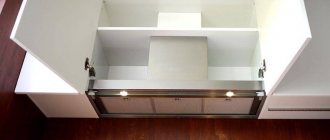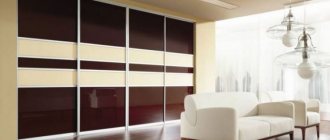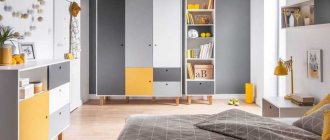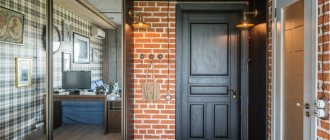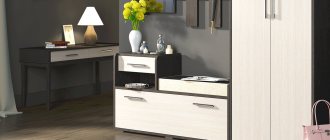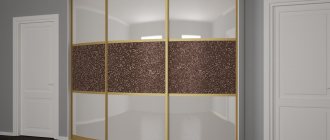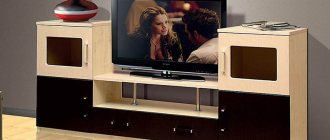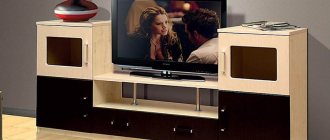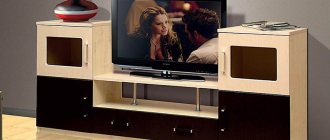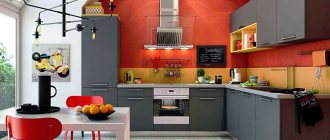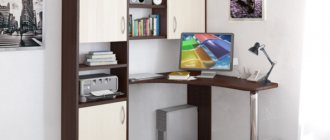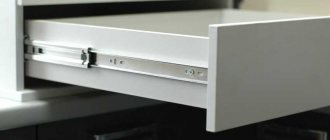Radius sliding wardrobe - features and advantages
The main purpose of any wardrobe is to store a variety of items; the radius model is no exception. The peculiarity of the radial module is the curved shape of both the facade itself and the guides along which the door leaves move. The curvilinear shape of the facade looks harmonious in the interior and has the ability to visually change the space, smoothing out sharp lines in the room.
The main advantages of radial storage systems with a compartment opening mechanism are:
- versatility - the product can be used as storage in small and spacious rooms. Furniture can be installed both in the corner of the room and along flat sections of the walls;
- practicality - a wide range of models allows you to choose a radius cabinet for storing any items;
- ergonomics – no additional space is required to open the door leaves.
The disadvantages of a module with a radius facade include considerable cost and difficulty in installing furniture. Having decided to choose a radial model, it is better to entrust its installation to professionals. Correct installation will ensure trouble-free operation of the storage system.
Design Features
The features of a closet in the living room are largely determined by its purpose. The internal content must be thought out in such a way that the furniture satisfies the needs of a person in this particular room. This also applies to the radius model, which is planned to be installed in the hall. But such furniture has a more significant feature - the unusual shape of the doors.
Not all types of natural wood can be bent at an angle, however, there are those that allow you to make hinged curved cabinet doors. In the case of a sliding system, the doors slide apart along a curved track on rollers. The system is quite complex and expensive, which explains the higher cost of furniture of this type compared to standard cabinet models. It is practically impossible to reduce the cost, which is why a radius cabinet in the hallway will emphasize the wealth of the family and the refined taste of a person.
Types of radius cabinets
Radius sliding wardrobes differ from each other in bending radius. There are three types of facades:
- concave;
- convex;
- wavy.
A concave radial cabinet has door leaves that are “pressed” inward. The internal radius gives additional depth to the space, visually expanding it, smoothing out the architectural errors of the room - the curvature of the ceiling and walls. Concave structures are ideal for filling niches in walls.
The outer bending radius allows the wardrobe to be used in rooms with a small area, since the module has a small width. At the same time, the semicircular shape of the facade increases the internal volume of the storage system. Convex models are often used in the interior of hallways or corridors. The outer bend can be performed with axial or asymmetric repetition.
Wave-like models combine external and internal curves. Radial sliding wardrobes with a variable radius are often installed in spacious living rooms and bedrooms.
Radial storage systems are also divided into corner and attached types. Corner structures are placed in the corner of the room; the cross-section of such a cabinet forms a sector of a circle. The shape of the module allows you to fill the corner space as tightly as possible. The main advantage of triangular cabinets with a rounded front is their high ergonomics.
Attached models of radius sliding wardrobes can have a square or rectangular cross-section. The modules will fit perfectly into a room with the correct geometry.
Manufacturing materials
The curved fronts of the cabinets give them a special appeal. The main elements of furniture are the body, sliding system, facades, internal content, decor. What materials can be used in the manufacture of hallway cabinets:
- Chipboard (chipboard) is a durable, practical material. Used for assembling housing and facades;
- LDSP (laminated chipboards) is a moisture-resistant, durable material. Used for the manufacture of buildings and facades;
- MDF (medium density fibreboard). They are used to make the facades of a radius sliding wardrobe in the hallway;
- HDF (high-density fiberboard) - excellent material strength, used for facades;
- veneer is an environmentally friendly material obtained from wood. Used for decorative design of facades made of chipboard, MDF;
- solid wood - when making furniture for the hallway, it is used to assemble the body. Makes the structure heavier and is expensive;
- furniture panel - glued lamellas made of hard wood - beech, oak, ash. Used for cases, drawers, shelves.
The main role in the curved design is played by the sliding door system and its contents. Radial facades can be made of laminated plastic, acrylic glass with photo printing, artificial leather, tinted triplex, rattan, bamboo, sandblasted glass.
Sliding systems for radius sliding wardrobes – a set of aluminum profiles with rollers. If hinged radial doors are installed, hinges for curved facades are used for their installation. In this case, the radius and chord are taken into account (external for concave parts, internal for convex elements).
Wood
Chipboard
MDF
Features of the sliding door system in radius cabinets - types of mechanisms
The opening system for radial modules also has its own characteristics in comparison with sliding wardrobes with straight fronts. The key elements of a radius sliding system are:
- curved guide;
- rollers;
- stoppers for fixing the blade in the desired position.
In the designs of radial sliding wardrobes, two types of sliding mechanisms are used:
- top-hung;
- with bottom support.
With a suspended sliding mechanism, a curved guide is attached to the ceiling or the top of the module frame. With a top-hung opening system, there are no lower guides in the design. The movement of the door leaves is ensured by plastic bearings installed at the bottom of the leaves. The top-hung sliding mechanism ensures silent movement of the door leaves. But at the same time, the mechanism itself requires regular maintenance, since the entire load falls on the upper rollers, otherwise the suspended sliding system can quickly fail.
It is not allowed to attach the upper guide rail to a suspended or suspended ceiling. An increased load on the upper profile can lead to the collapse of the ceiling structure.
In wardrobe designs with a bottom sliding system, the guides are fixed to the floor or the lower part of the frame. Sliding doors move along a curved rail using rollers. Rollers are installed in the upper part of the door leaf to fix the front part in the opening, which prevent the leaves from falling out when opened.
The advantages of the bottom-support sliding system are:
- reliability of design;
- uniform load distribution;
- ability to withstand considerable weight of door panels;
- long service life.
The negative side is that the bottom rail gets dirty quickly. The presence of debris in the guide makes it difficult for the blades to slide. To prevent the mechanism from jamming, you should regularly clean the track with a vacuum cleaner.
Facade design
The appearance of the furniture depends on the finishing materials, decor, and colors used. In most cases, profiles for radius sliding wardrobes are made of aluminum. The most popular facade finishing options include:
- Lamination - such surfaces are resistant to household chemicals, moisture, and are not afraid of mechanical stress. The popularity of the material is explained by its ease of processing, low maintenance, and affordable cost.
- Mirrors improve lighting and visually increase the space of a room. For safety, the surface is covered with a shockproof film.
- Glass - facades can be glossy or matte, the decor is done using sandblasting and etching.
- Plastic - comes in a variety of colors, it is light weight, but such a facade needs protection from scratches and other mechanical damage.
Methods of decorating mirrored facades of sliding wardrobes
Laminated surface
Mirrors
Glass
Plastic
Various combinations of materials are in fashion. The finishing of a radius wardrobe with a mirror is complemented by wood and plastic, glass is combined with MDF or chipboard. A popular design is in the form of thin metal strips that divide the surface into squares and diamonds, which are filled with stained glass windows and reflective canvases. To decorate original cabinets, non-standard options are used:
- Textured eco-leather - looks respectable and solid, will organically fit into the interior of a library, bedroom or office. The material is in harmony with metal, glass, wood.
- Metal inserts look unusual and are used to divide the door leaf into geometric shapes.
- 3D drawings - urban paintings in black and white and color, inscriptions, slogans, interesting ornaments are popular.
- Solvent, ultraviolet, polymer printing is performed using special inks. Images are bright and long lasting.
- Rattan - a lightweight, beautiful material of plant origin will make an ordinary straight cabinet a real decoration for a room decorated in an ethnic or Japanese style.
The colors of radius models come in a wide variety, but natural wood shades are the most popular. These are exquisite wenge, maple, rich tones of cherry, apple, noble oak, beech. A white cabinet looks luxurious, as well as milk, vanilla, and ivory.
Furniture finishing should match the interior or contrast with it. Cabinets can be painted in light yellow, salmon, blue, soft pink, green shades.
Textured eco-leather inserts
Metal elements
3D drawing
UV printing
With rattan
Fronts of radius sliding wardrobes
The front of a radial cabinet is not only a structural element of a piece of furniture, this curvilinear detail gives the product a stylish and creative look. The radius of curvature of the façade has limitations that are associated with the bending limit of façade materials. Convex modules can have an outer radius from 300 to 1000 mm, while concave modules have a single value of 300 mm.
The number of door leaves on the front part is calculated based on the length of the arc. The components of the curved façade are identical in width. One door leaf should not be less than 0.5 m; the optimal option is considered to be doors with a width of 0.6-0.9 m.
The structural elements of the door leaf of the radial storage system are:
- side vertical profiles;
- internal filling of the valves;
- a seal that is fixed on the vertical side profiles and ensures soft closing of the doors, preventing dust from entering the interior of the cabinet.
The following materials are used to create façade elements:
- MDF;
- plastic;
- tempered glass framed with aluminum profile.
The door leaves of a radius cabinet can be made using natural wood. However, wooden facades are not widely used due to their high cost.
Types of decorative coatings
In order to impart decorative qualities to the front side of the wardrobe, furniture manufacturers use various finishing materials. To cover the facade the following is used:
- mirror inserts – visually expand the space, can be decorated with a sandblasted image;
- photo printing opens up wide design possibilities. The basis of the photographic image can be self-adhesive film or paper;
- leather – inserts made of natural or artificial leather give the façade a special chic. Decorative leather inserts are harmoniously combined with other finishing materials. Provide additional protection of facade material from moisture;
- stained glass inserts – the coating gives the product an exquisite pretentiousness. Stained glass windows are ideal for rooms decorated in both classical and modern styles;
- veneer – the veneering method gives the base material the noble structure of natural wood, increases the strength and wear resistance of facade elements.
Types of designs of radius cabinets with sliding doors
By design, radial sliding wardrobes can be framed or built-in. Hull models are a complete structure with walls, roof and bottom. The key advantage of models with a frame is mobility - the cabinet can be moved from place to place. But in comparison with built-in analogues, cabinet products have a smaller internal volume due to the thickness of the side walls, and the cost of frame furniture will be an order of magnitude higher.
Built-in wardrobes are frameless products. The ceiling and floor act as the top cover and bottom, and the walls of the room act as the sides and back surface. The integral structural elements of embedded systems are the façade and the internal equipment of the module. Furniture is made in accordance with the geometric data of the location, so moving the cabinet to another location is very problematic.
Internal filling
There are a huge number of options for internal filling of a radius sliding wardrobe. Planning the interior space of the cabinet is directly related to the functional purpose of the piece of furniture.
Curvilinear models of wardrobes for hallways are equipped with hooks, trellises, drawers, shelves, and shoe storage systems. Bookcases are filled with shelves. In addition to shelves and drawers, wardrobe storage systems are equipped with hanging rods, trouser and skirt racks, mechanisms for storing ties, mezzanine shelves for storing seasonal clothing, blankets and other large items.
Radius cupboards are equipped with glass shelves; often the interior of the module is equipped with LED lighting. The combination of glass shelves with an agenda most advantageously emphasizes the beauty of exclusive items, decorative plates, sets and other cutlery.
Recommendations for choosing radius sliding wardrobes
In order for a cabinet with a curved front to last a long time, the choice of model should be approached with particular care. You should decide on the installation location of the module before purchasing, and also choose the type of structure and shape of the facade. The external design of the front side should be in harmony with the overall interior of the room.
An important criterion for choosing radial systems is the opening mechanism. The sliding system should operate smoothly and without unnecessary noise. The thickness of the metal curved profile should not be less than 1.2 mm.
Before purchasing, you need to study the quality of the materials used. Structural elements must not have defects, cracks or chips. There should be no foreign odors coming from the furniture.
The internal content of the wardrobe must correspond to the functional purpose of the furniture item.
Radius wardrobes are not just storage, they are an artistic element of room design. You can choose a radius sliding wardrobe to decorate almost any room in the apartment. The combination of originality, style and practicality makes wardrobes with a curved front an ideal piece of furniture.
Basic radial schemes
The range of radius cabinets is presented in several varieties, which differ in shape. When choosing, the parameters of the installation location and individual preferences are taken into account. Manufacturers offer the following options:
- Curved - a model in the form of a hemisphere with narrow side walls. Typically used to design built-in wardrobes, which are mounted in specially designated niches. An ideal scheme for areas where it is impossible to install standard structures.
- Concave - the door leaf is slightly recessed inward relative to the side walls. It is characterized by less capacity compared to the curved shape, but is distinguished by smooth lines and the ability to visually increase space.
- Combined or concave-convex - a radius cabinet combines the features of two varieties and has a wave-like shape. The models will become an original interior decoration.
- Asymmetrical - compact in size, high capacity. When decorating doors with reflective sheets, it helps to visually expand the space.
- Round - looks unusual, harmonizes with modern interior styles.
- Only with a side radius section - in appearance it resembles standard rectangular cabinets, in which one side is rounded. The products save space and look unusual.
Purpose of rollers for sliding wardrobes, methods of installing elements.
The choice of the optimal scheme depends on the characteristics of the room. Curved radius models are installed in small closets and hallways, which are converted into a dressing room. Cabinets with concave doors are often used to decorate a classic interior; asymmetrical ones are relevant for rectangular rooms. Round products are installed in spacious halls, living rooms, and serve to zone space.
Curved
Concave
Combined
Asymmetric
Round
With side radius section
